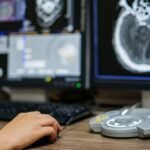In a world where science and technology are evolving faster than ever, modern medicine stands as a testament to human ingenuity. Diseases that once spelled certain death are now manageable—or even curable. Surgeries that required large incisions are now done with robotic precision. From AI-powered diagnostics to revolutionary gene therapies, today’s medical breakthroughs are not just innovations; they’re life-saving realities.
This article dives deep inside modern medicine, exploring the most impactful breakthroughs, their real-world applications, and how they are transforming lives across the globe.
The Power of Early Detection Modern Medicine

AI-Enhanced Diagnostics
Artificial Intelligence (AI) is now one of the most powerful tools in diagnostics. It can analyze massive volumes of medical data, including scans, lab results, and genetic markers, with astonishing speed and accuracy.
Examples:
- Lung Cancer Detection: AI can analyze CT scans to detect early-stage lung cancer up to a year earlier than traditional methods.
- Skin Cancer Analysis: Dermatology tools using AI match or even exceed expert-level performance in identifying malignant moles.
- Heart Disease Prediction: AI algorithms detect subtle patterns in EKGs, identifying risk of cardiac events weeks in advance.
Liquid Biopsies
Traditional biopsies are invasive and risky. Liquid biopsies, which analyze fragments of DNA in the blood, allow doctors to detect cancers early and monitor treatment responses with a simple blood draw.
Benefits:
- Early detection of solid tumors before symptoms arise.
- Non-invasive and repeatable testing.
- Real-time monitoring of metastasis or recurrence.
Next-Generation Treatments That Heal
Immunotherapy
Instead of poisoning cancer cells (as chemotherapy does), immunotherapy activates the body’s own immune system to attack the disease.
Breakthroughs:
- Checkpoint Inhibitors: Drugs like pembrolizumab (Keytruda) have extended survival in melanoma, lung, and bladder cancers.
- CAR T-Cell Therapy: Personalized treatment where a patient’s T-cells are re-engineered to target cancer. Effective in certain leukemias and lymphomas.
mRNA Vaccines and Therapies
Once an experimental technique, mRNA technology became a household term during the COVID-19 pandemic. Now, it is revolutionizing vaccine development and beyond.
Applications:
- New vaccines for flu, RSV, and malaria.
- mRNA-based cancer vaccines in development.
- Potential use for autoimmune and rare genetic diseases.
Gene Editing with CRISPR
The ability to precisely “cut and fix” genes is changing how we approach inherited diseases.
Success Stories:
- Sickle cell anemia patients have been functionally cured through CRISPR-based therapies.
- Trials underway for genetic blindness, Huntington’s disease, and certain forms of muscular dystrophy.
- Ethical and safety concerns are being carefully addressed as the technology matures.
Technology at the Bedside

Robotic-Assisted Surgery
Surgical robots, like the da Vinci Surgical System, allow for less invasive, more precise procedures.
Benefits:
- Shorter recovery time and less pain.
- Reduced surgical complications.
- Improved visualization and dexterity in complex surgeries (e.g., prostate, gynecologic, cardiac).
Smart Prosthetics and Bionics
Thanks to advances in neuroscience and materials engineering, prosthetics are no longer static tools—they are integrated, sensory, and responsive.
Modern Features:
- Prosthetic limbs controlled by brain signals or muscle movements.
- Bionic eyes restoring partial vision in patients with retinal damage.
- Haptic feedback giving amputees a sense of touch.
Wearable Health Tech
Devices like Apple Watch and Fitbit now do more than count steps—they save lives.
Examples:
- Early detection of arrhythmias like atrial fibrillation.
- Monitoring blood oxygen levels and sleep apnea.
- Integration with health systems to trigger alerts and emergency response.
Revolution in Regeneration and Recovery
3D Bioprinting
Bioprinting is the use of 3D printing technologies to create structures like tissues, bones, and even organ components.
In Development:
- Skin grafts for burn victims.
- Cartilage for orthopedic reconstruction.
- Lab-grown mini-organs (organoids) for drug testing and disease modeling.
Stem Cell Therapy
Stem cells offer the potential to repair or replace damaged tissues and organs.
Progress:
- Treatment of spinal cord injuries and stroke.
- Stem cells to regenerate heart tissue after a heart attack.
- Reversal of some degenerative eye diseases.
Digital Medicine and Remote Care
Telehealth and Virtual Care
Telemedicine is not a pandemic trend—it’s now a foundational element of modern care.
Impact:
- Chronic disease management from home.
- Increased access to specialists in rural or underserved areas.
- Reduced hospital crowding and exposure risks.
Mobile Health (mHealth) Apps
Digital health apps track symptoms, dispense medication reminders, and offer therapeutic interventions.
Examples:
- Diabetes apps syncing with glucose monitors.
- Mental health apps offering guided therapy.
- Medication adherence platforms reducing readmissions.
Breakthroughs in Mental Health

Psychedelic-Assisted Therapy
After decades of prohibition, psychedelics like psilocybin and MDMA are being recognized for their potential in treating PTSD, depression, and anxiety.
Research Highlights:
- MDMA-assisted therapy is in Phase 3 trials for PTSD.
- Psilocybin shows lasting effects after just two sessions for treatment-resistant depression.
- Clinics emerging under strict regulatory guidance.
Digital Psychiatry
AI-powered platforms and mobile apps are helping diagnose, monitor, and even treat mental health conditions.
Tools in Use:
- Chatbots offering CBT-based interventions.
- AI analyzing vocal tone for early signs of psychosis.
- Remote mood tracking using passive smartphone data.
Public Health and Pandemic Preparedness
Genomic Surveillance
The pandemic taught us the value of real-time data. Genomic sequencing now plays a key role in tracking variants and emerging diseases.
Applications:
- Real-time mutation monitoring for COVID, flu, monkeypox.
- Fast detection of antimicrobial resistance.
- Predictive modeling for outbreak hotspots.
Global Vaccine Distribution Platforms
New global collaborations ensure rapid and equitable vaccine distribution for future pandemics.
Key Programs:
- GAVI and COVAX expanding cold chain infrastructure.
- mRNA manufacturing hubs in Africa and South America.
- Early-stage research into “universal” vaccines for coronaviruses and influenza.
Conclusion
Modern medicine is advancing at a pace that is both exciting and awe-inspiring. Whether it’s curing once-fatal diseases, restoring mobility, enhancing mental well-being, or improving global health systems, these breakthroughs are not just science—they are stories of lives saved, pain alleviated, and futures rewritten.
However, these innovations also come with challenges: affordability, ethical concerns, regulatory hurdles, and the need for equitable access. As we look ahead, the future of medicine will depend not only on technological prowess but also on human compassion, inclusive policy, and global cooperation.
We’re no longer just treating illness. We’re redefining what it means to be healthy.
Also Read : The Science Behind Gene Therapy: Unveiling The Mysteries Of DNA!
Frequently Asked Questions (FAQs)
What is the biggest breakthrough in medicine today?
While many breakthroughs are significant, mRNA technology stands out for its rapid impact, particularly in vaccine development, with future potential in cancer and autoimmune diseases.
How is AI helping in healthcare?
AI assists in diagnostic imaging, treatment planning, remote monitoring, and even predicting patient deterioration. It reduces errors and improves outcomes.
What diseases can be cured with gene editing?
Gene editing using CRISPR is showing promise in sickle cell anemia, beta-thalassemia, and inherited eye diseases, with more applications in clinical trials.
Are robotic surgeries safe?
Yes, robotic-assisted surgeries are generally safe and often more precise than traditional methods, leading to quicker recovery and fewer complications.
Can technology help with mental health?
Absolutely. Digital mental health tools like therapy apps, AI chatbots, and remote counseling platforms are expanding access and improving outcomes.
What is a liquid biopsy?
It’s a non-invasive blood test that detects cancer-related DNA fragments. It’s used for early diagnosis, monitoring, and assessing treatment response.
How do mRNA vaccines differ from traditional vaccines?
Unlike traditional vaccines that use weakened pathogens, mRNA vaccines teach cells to produce a harmless piece of the virus, triggering an immune response safely and efficiently.
What’s the future of organ transplants?
3D bioprinting and stem cells are shaping the future, potentially eliminating the need for organ donors by creating lab-grown or bioengineered organs.
Is telehealth effective?
For many conditions—especially follow-ups, mental health, and chronic disease—it’s as effective as in-person visits and greatly enhances accessibility.
Are psychedelic therapies legal?
Currently, most are under clinical trials and not widely legal. However, FDA breakthroughs and decriminalization in some regions suggest a changing landscape.




